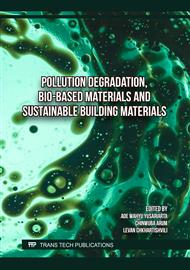[1]
I. X. Yin, J. Zhang, I. S. Zhao, M. L. Mei, Q. Li, and C. H. Chu, "The Antibacterial Mechanism of Silver Nanoparticles and Its Application in Dentistry," Int. J. Nanomedicine, vol. Volume 15, p.2555–2562, Apr. 2020.
DOI: 10.2147/IJN.S246764
Google Scholar
[2]
N. S. Alharbi, N. S. Alsubhi, and A. I. Felimban, "Green synthesis of silver nanoparticles using medicinal plants : Characterization and application," J. Radiat. Res. Appl. Sci., vol. 15, no. 3, p.109–124, 2022.
DOI: 10.1016/j.jrras.2022.06.012
Google Scholar
[3]
P. Nie, Y. Zhao, and H. Xu, "Synthesis, applications, toxicity and toxicity mechanisms of silver nanoparticles: A review," Ecotoxicol. Environ. Saf., vol. 253, no. February, p.114636, 2023.
DOI: 10.1016/j.ecoenv.2023.114636
Google Scholar
[4]
S. Ahmed, M. Ahmad, B. L. Swami, and S. Ikram, "A review on plants extract mediated synthesis of silver nanoparticles for antimicrobial applications: A green expertise," J. Adv. Res., vol. 7, no. 1, p.17–28, 2016.
DOI: 10.1016/j.jare.2015.02.007
Google Scholar
[5]
M. Naveed et al., "Green Synthesis of Silver Nanoparticles Using the Plant Extract of Acer oblongifolium and Study of Its Antibacterial and Antiproliferative Activity via Mathematical Approaches," Molecules, vol. 27, no. 13, p.1–15, 2022.
DOI: 10.3390/molecules27134226
Google Scholar
[6]
A. Deljou and S. Goudarzi, "Green extracellular synthesis of the silver nanoparticles using Thermophilic Bacillus Sp. AZ1 and its antimicrobial activity against several human pathogenetic bacteria," Iran. J. Biotechnol., vol. 14, no. 2, p.25–32, 2016.
DOI: 10.15171/ijb.1259
Google Scholar
[7]
G. O. Akintayo et al., "Synthesis, bioactivities and cytogenotoxicity of animal fur-mediated silver nanoparticles," IOP Conf. Ser. Mater. Sci. Eng., vol. 805, no. 1, 2020.
DOI: 10.1088/1757-899X/805/1/012041
Google Scholar
[8]
P. Herrera-Marín, L. Fernández, F. Pilaquinga F., A. Debut, A. Rodríguez, and P. Espinoza-Montero, "Green synthesis of silver nanoparticles using aqueous extract of the leaves of fine aroma cocoa Theobroma cacao linneu (Malvaceae): Optimization by electrochemical techniques," Electrochim. Acta, vol. 447, no. October 2022, p.0–8, 2023.
DOI: 10.1016/j.electacta.2023.142122
Google Scholar
[9]
M. K. Husam, "The effect of pH , Temperature on the green synthesis and biochemical activities of silver nanoparticles from Lawsonia inermis extract," J. Pharm. Sci. Res., vol. 10, no. 1, p.2022–2026, 2022.
Google Scholar
[10]
A. Nabikhan, K. Kandasamy, A. Raj, and N. M. Alikunhi, "Synthesis of antimicrobial silver nanoparticles by callus and leaf extracts from saltmarsh plant, Sesuvium portulacastrum L.," Colloids Surfaces B Biointerfaces, vol. 79, no. 2, p.488–493, 2010.
DOI: 10.1016/j.colsurfb.2010.05.018
Google Scholar
[11]
B. Kumar, K. Smita, L. Cumbal, and A. Debut, "Ficus carica (Fig) Fruit Mediated Green Synthesis of Silver Nanoparticles and its Antioxidant Activity: a Comparison of Thermal and Ultrasonication Approach," Bionanoscience, vol. 6, no. 1, p.15–21, 2016.
DOI: 10.1007/s12668-016-0193-1
Google Scholar
[12]
A. Wibowo et al., "Green Synthesis of Silver Nanoparticles Using Extract of Cilembu Sweet Potatoes ( Ipomoea batatas L var . Rancing ) as," Molecules, vol. 26, no. 2042, p.1–22, 2021, doi: https://doi.org/.
DOI: 10.3390/molecules26072042
Google Scholar
[13]
A. Rahman, A. K. M. B. Rashid, M. A. A. Antor, M. A. Anwar, and R. H. Galib, "Green Synthesis and Characterization of Silver Nanoparticles by Using Aloe Vera Leaf Extract to Study the Effects of Synthesis Parameters," Appl. Mech. Mater., vol. 860, p.179–184, 2016.
DOI: 10.4028/www.scientific.net/amm.860.179
Google Scholar
[14]
M. B. Ananda et al., "Fast Microwave-Assisted Green Synthesis of Silver Nanoparticles Using Low Concentration of Seminyak (Champeria sp.) Leaf Extract," Indones. J. Chem., vol. 23, no. 2, p.395–404, 2023.
DOI: 10.22146/ijc.78545
Google Scholar
[15]
A. O. Dada et al., "Exploring the Effect of Operational Factors and Characterization Imperative to the Synthesis of Silver Nanoparticles," Silver Nanoparticles - Fabr. Charact. Appl., 2018.
DOI: 10.5772/intechopen.76947
Google Scholar


